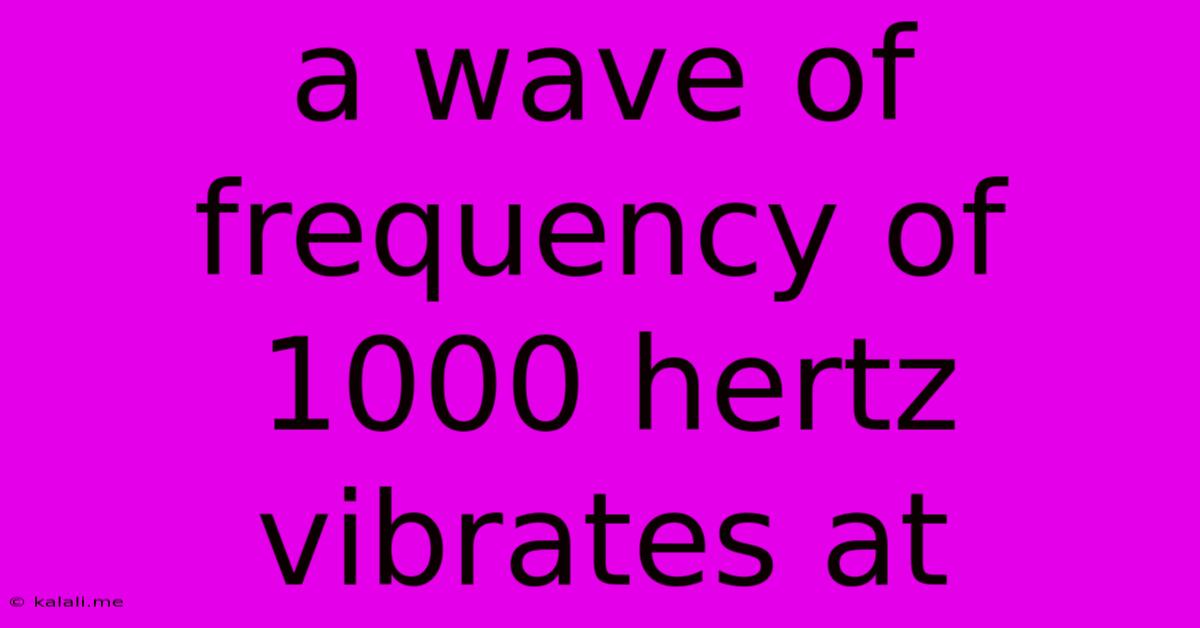A Wave Of Frequency Of 1000 Hertz Vibrates At
Kalali
Jun 15, 2025 · 3 min read

Table of Contents
A Wave of Frequency: Exploring the Vibrations of 1000 Hertz
A 1000 Hertz (Hz) wave vibrates 1000 times per second. This seemingly simple statement opens the door to understanding a vast world of phenomena, from the audible sounds we hear to the invisible waves that power our technology. This article delves into the characteristics and implications of a 1000 Hz wave, exploring its properties and its place within the broader electromagnetic spectrum and the realm of sound.
Understanding Frequency and Wavelength:
Frequency, measured in Hertz (Hz), represents the number of complete oscillations or cycles a wave completes in one second. Wavelength, on the other hand, is the distance between two consecutive corresponding points on a wave (e.g., crest to crest or trough to trough). These two properties are inversely proportional; a higher frequency means a shorter wavelength, and vice versa. The relationship is defined by the equation: velocity = frequency x wavelength. The velocity depends on the medium the wave is traveling through (e.g., air, water, or a solid).
1000 Hz in the Context of Sound:
A 1000 Hz sound wave falls squarely within the human hearing range (generally considered to be 20 Hz to 20,000 Hz). It's relatively high-pitched, somewhere in the middle to upper register of a human voice or a musical instrument. The specific pitch perceived would depend on the timbre (tone color), which is influenced by the complex interplay of various frequencies present in the sound wave. For example, a pure tone at 1000 Hz would sound significantly different from a complex sound containing a 1000 Hz fundamental frequency and several harmonics.
Beyond Audible Sound: Electromagnetic Waves:
While the example above pertains to sound waves, which are mechanical waves, the concept of frequency applies equally to electromagnetic waves (light, radio waves, X-rays, etc.). However, a 1000 Hz frequency is exceedingly low for electromagnetic waves. The electromagnetic spectrum operates at far higher frequencies, typically measured in kilohertz (kHz), megahertz (MHz), gigahertz (GHz), and even terahertz (THz) and beyond. Radio waves, for instance, occupy the lower end of the electromagnetic spectrum and are commonly found in the kilohertz and megahertz ranges. Visible light, on the other hand, sits at much higher frequencies, in the hundreds of terahertz.
Applications of 1000 Hz and Related Frequencies:
Frequencies around 1000 Hz are used in various applications:
- Audio Engineering: 1000 Hz often serves as a reference point in audio equalization and tuning, helping engineers balance the sound across different frequencies.
- Musical Instruments: Many musical instruments produce sounds with significant energy in the 1000 Hz range.
- Communication Systems: While not directly at 1000 Hz, frequencies in the kilohertz range are used in some communication systems.
Conclusion:
A 1000 Hz wave, whether a sound wave or part of a more complex electromagnetic wave, demonstrates the fundamental principle of wave behavior. Understanding frequency and wavelength is crucial for comprehending how energy propagates through various mediums. This single frequency represents a point on a continuous spectrum of vibrations that shape our world, from the music we enjoy to the technology that connects us. Further exploration into specific applications of this and similar frequencies will reveal even more about their impact on our daily lives.
Latest Posts
Latest Posts
-
How To Create Clickable Image In Html
Jun 16, 2025
-
What Are The Factors Of 121
Jun 16, 2025
-
What Is A Theme Of The Passage
Jun 16, 2025
-
A Company That Provides Access To The Internet
Jun 16, 2025
-
Which Word Is Closest In Meaning To The Underlined Word
Jun 16, 2025
Related Post
Thank you for visiting our website which covers about A Wave Of Frequency Of 1000 Hertz Vibrates At . We hope the information provided has been useful to you. Feel free to contact us if you have any questions or need further assistance. See you next time and don't miss to bookmark.